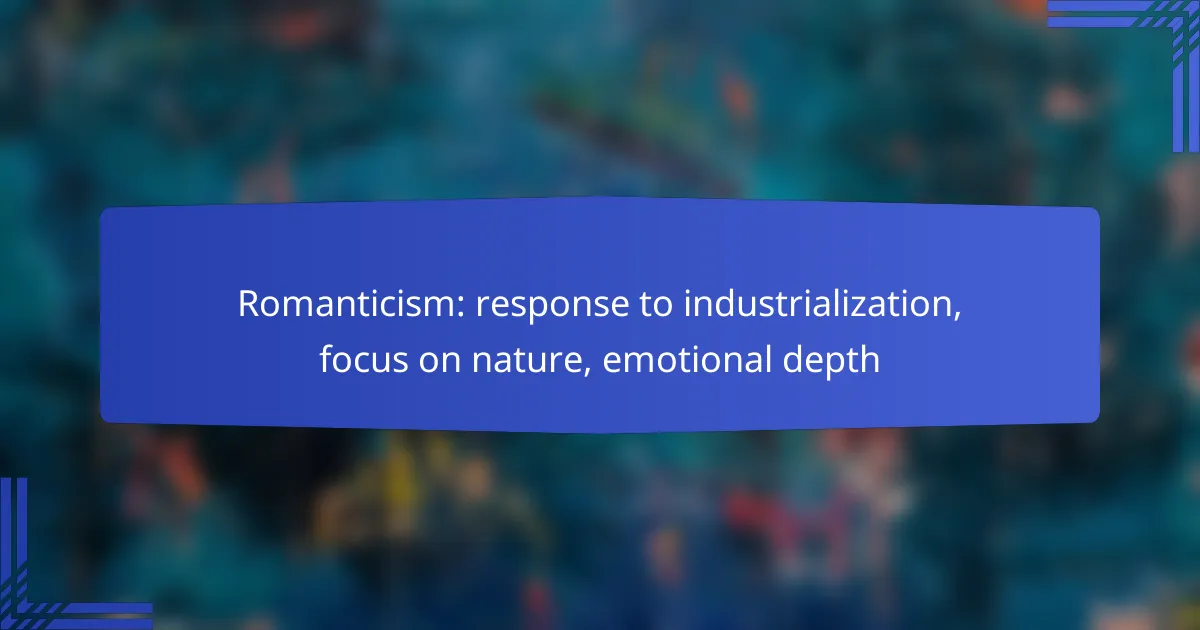Romanticism arose as a powerful response to the sweeping changes brought by industrialization, emphasizing emotional depth and a profound connection to nature. This movement critiqued the dehumanizing effects of industrial society, celebrating individual experience and the beauty of the natural world as sources of inspiration and spiritual renewal.
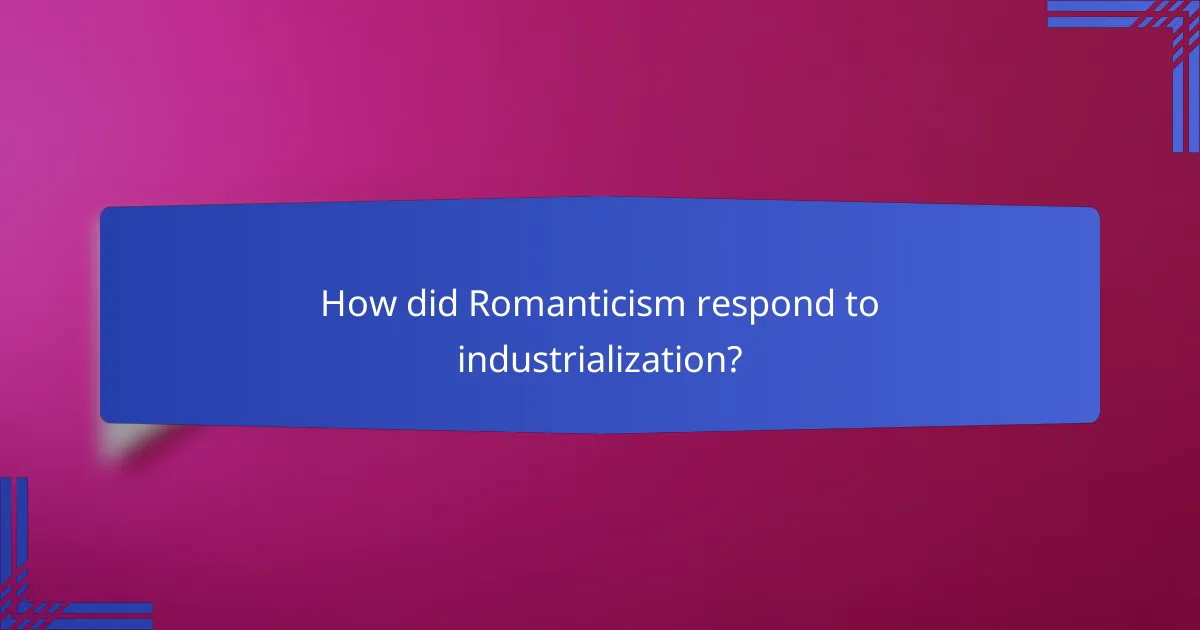
How did Romanticism respond to industrialization?
Romanticism emerged as a reaction to industrialization, emphasizing emotional depth and a connection to nature. It critiqued the dehumanizing aspects of industrial society while celebrating individual experience and rural life.
Critique of industrial society
Romanticism challenged the rapid changes brought by industrialization, which often led to poor working conditions and environmental degradation. Artists and writers highlighted the loss of individuality and the mechanization of human life, portraying industrial society as cold and oppressive.
Many Romantic figures advocated for a return to simpler, more meaningful ways of living. They argued that industrial progress often came at the expense of human values, urging society to reconsider its priorities and reconnect with nature.
Emphasis on individual experience
Romanticism placed a strong focus on personal feelings and subjective experiences, valuing the individual’s emotional response to the world. This emphasis on individualism encouraged people to explore their inner thoughts and feelings, often leading to a deeper appreciation of art and nature.
Writers and poets expressed their unique perspectives through vivid imagery and emotional language, allowing readers to connect with their experiences on a personal level. This focus on the individual helped to foster a sense of authenticity and personal truth in creative expression.
Celebration of rural life
Romanticism celebrated rural life as a counterpoint to the industrialized urban experience. Artists depicted pastoral scenes and the beauty of nature, emphasizing the simplicity and authenticity found in rural settings.
This celebration often included themes of nostalgia for a pre-industrial past, where life was perceived as more harmonious and connected to the natural world. The Romantic movement encouraged a reevaluation of rural communities as sources of inspiration and moral clarity, contrasting sharply with the chaos of industrial cities.
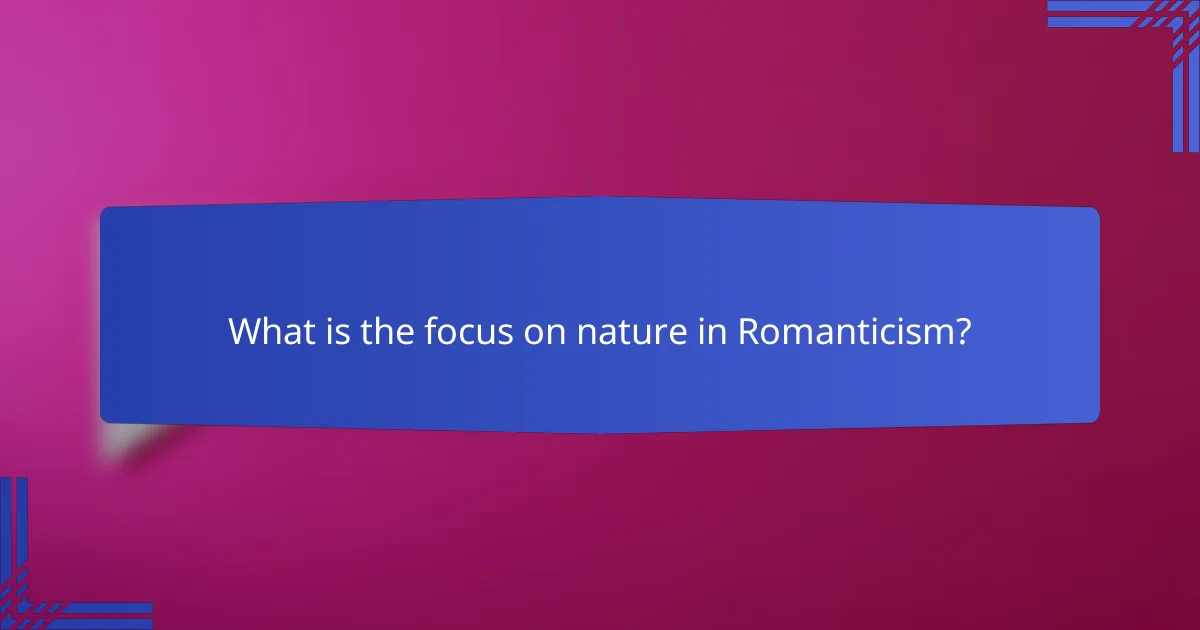
What is the focus on nature in Romanticism?
The focus on nature in Romanticism emphasizes its beauty, power, and emotional resonance, serving as a counterpoint to the industrialization of the 18th and 19th centuries. Romantic artists and writers sought to explore the deep connections between humanity and the natural world, often portraying nature as a source of inspiration and spiritual renewal.
Nature as a source of inspiration
Romanticism views nature as a wellspring of creativity and emotional depth. Poets and painters often depicted landscapes, flora, and fauna to evoke feelings of awe and wonder. For instance, the works of William Wordsworth celebrate the beauty of the English countryside, suggesting that immersion in nature can lead to profound insights and personal growth.
Artists like Caspar David Friedrich used dramatic natural scenes to convey human emotions, illustrating how nature can reflect inner turmoil or tranquility. This connection encourages individuals to seek solace and inspiration in the natural world, especially in times of societal upheaval.
Symbolism of natural elements
In Romantic literature and art, natural elements often carry deep symbolic meanings. Mountains might represent strength and permanence, while rivers can symbolize the passage of time and life’s journey. These symbols help convey complex emotions and ideas, allowing audiences to connect with the work on a deeper level.
For example, the use of storms in Romantic poetry frequently symbolizes turmoil and conflict, while serene landscapes can evoke peace and harmony. Understanding these symbols enhances the appreciation of Romantic works, revealing the intricate relationship between nature and human experience.

How does Romanticism express emotional depth?
Romanticism expresses emotional depth by emphasizing individual feelings, personal experiences, and the profound connection between humans and nature. This movement highlights the importance of emotions as a response to the rationalism of industrialization, allowing for a deeper exploration of the human psyche.
Exploration of human emotions
Romantic literature and art delve into the complexities of human emotions, often portraying intense feelings such as love, sorrow, and passion. This exploration allows artists and writers to connect with audiences on a personal level, inviting them to reflect on their own emotional experiences.
For instance, works by poets like William Wordsworth and Lord Byron often center on the individual’s emotional journey, showcasing how personal feelings can shape one’s understanding of the world. This focus on emotional authenticity encourages a more profound appreciation of human experiences.
Use of intense imagery
Romanticism employs vivid and intense imagery to evoke strong emotional responses from the audience. By using descriptive language and powerful visual elements, artists and writers create immersive experiences that resonate deeply with viewers and readers.
Examples include the dramatic landscapes in the paintings of Caspar David Friedrich, which often symbolize inner turmoil and emotional depth. Similarly, the use of nature as a backdrop in poetry serves to amplify the emotional stakes, making feelings more tangible and relatable.
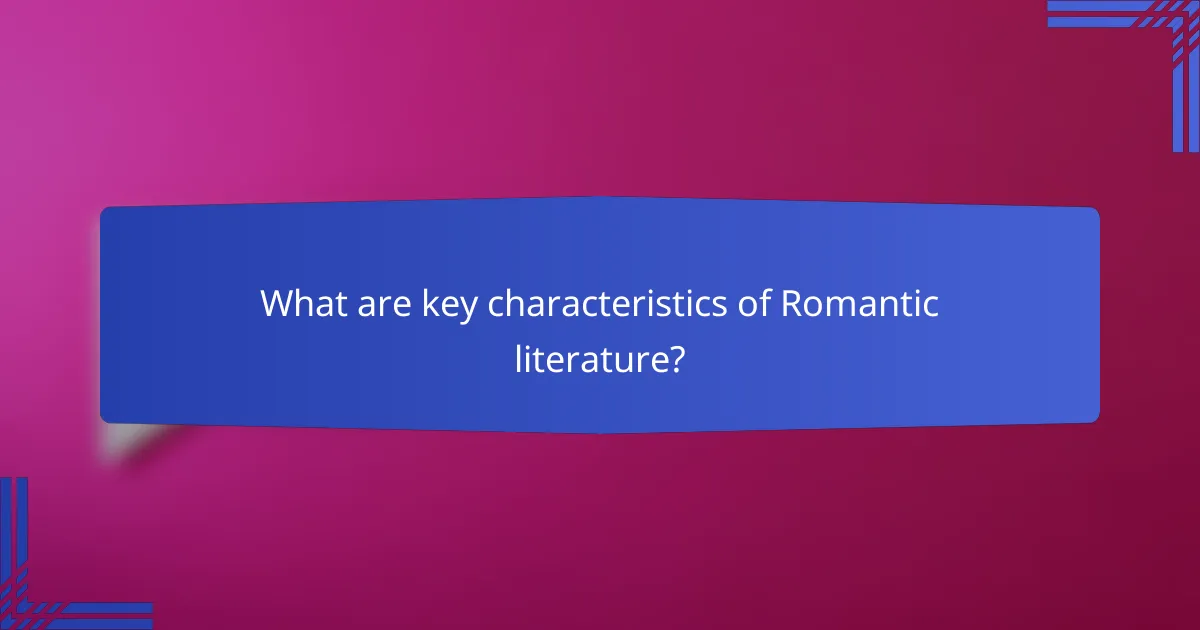
What are key characteristics of Romantic literature?
Romantic literature is characterized by its emphasis on emotion, nature, and individual experience, often as a response to the industrialization of society. It values personal feelings and the beauty of the natural world over the rationalism and order of the Enlightenment.
Focus on personal experience
Romantic literature places a strong emphasis on personal experience and individual emotions. Writers often explore their own feelings and thoughts, reflecting on how these internal states connect to the larger world. This focus allows readers to engage deeply with the characters’ journeys and emotional landscapes.
For example, poets like William Wordsworth celebrated the beauty of nature as a source of inspiration and personal reflection. This personal connection to nature often serves as a backdrop for exploring broader themes of love, loss, and identity.
Rejection of rationalism
Romantic literature rejects the strict rationalism of the Enlightenment, favoring intuition and emotion instead. This shift is evident in the way Romantic writers prioritize feelings over logic, often portraying the irrational aspects of human experience as essential to understanding life.
Authors like Edgar Allan Poe illustrate this rejection through their exploration of the darker sides of human emotion, such as fear and madness. By embracing the irrational, Romantic literature invites readers to experience the complexities of the human condition beyond mere reason.
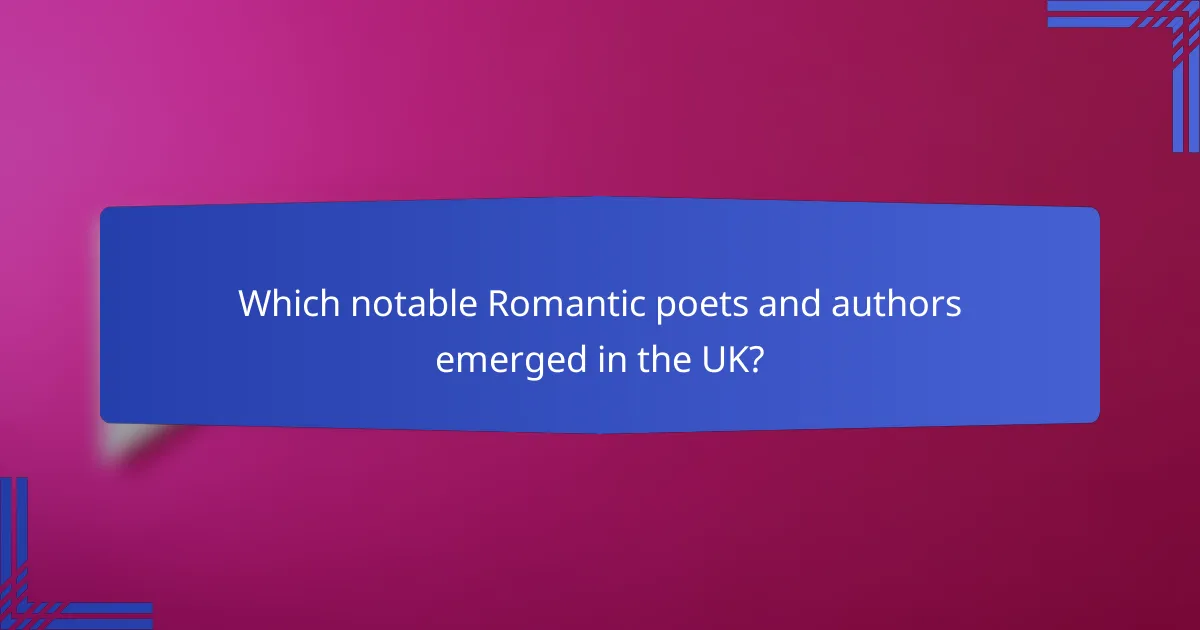
Which notable Romantic poets and authors emerged in the UK?
Several key figures defined the Romantic movement in the UK, emphasizing emotion, nature, and individualism in their works. Notable poets include William Wordsworth, Samuel Taylor Coleridge, and John Keats, each contributing uniquely to the literary landscape of the time.
William Wordsworth
William Wordsworth is celebrated for his profound connection to nature and the human experience. His poetry often reflects a deep appreciation for the natural world, emphasizing its beauty and spiritual significance.
Wordsworth’s most famous work, “Lines Composed a Few Miles Above Tintern Abbey,” illustrates his belief in the restorative power of nature. He often used simple language to convey complex emotions, making his poetry accessible and relatable.
Samuel Taylor Coleridge
Samuel Taylor Coleridge is known for his imaginative and philosophical approach to poetry. His works often explore themes of the supernatural and the sublime, blending emotion with vivid imagery.
Coleridge’s “The Rime of the Ancient Mariner” exemplifies his ability to weave intricate narratives that evoke deep feelings. His collaboration with Wordsworth in “Lyrical Ballads” marked a significant shift in English poetry, focusing on everyday experiences and emotions.
John Keats
John Keats is renowned for his rich imagery and exploration of beauty, love, and mortality. His poetry often reflects a sense of longing and the transient nature of life, inviting readers to appreciate the moment.
In poems like “Ode to a Nightingale,” Keats captures the essence of human emotion and the allure of nature. His work emphasizes the importance of sensory experience, making his themes resonate with readers on a personal level.
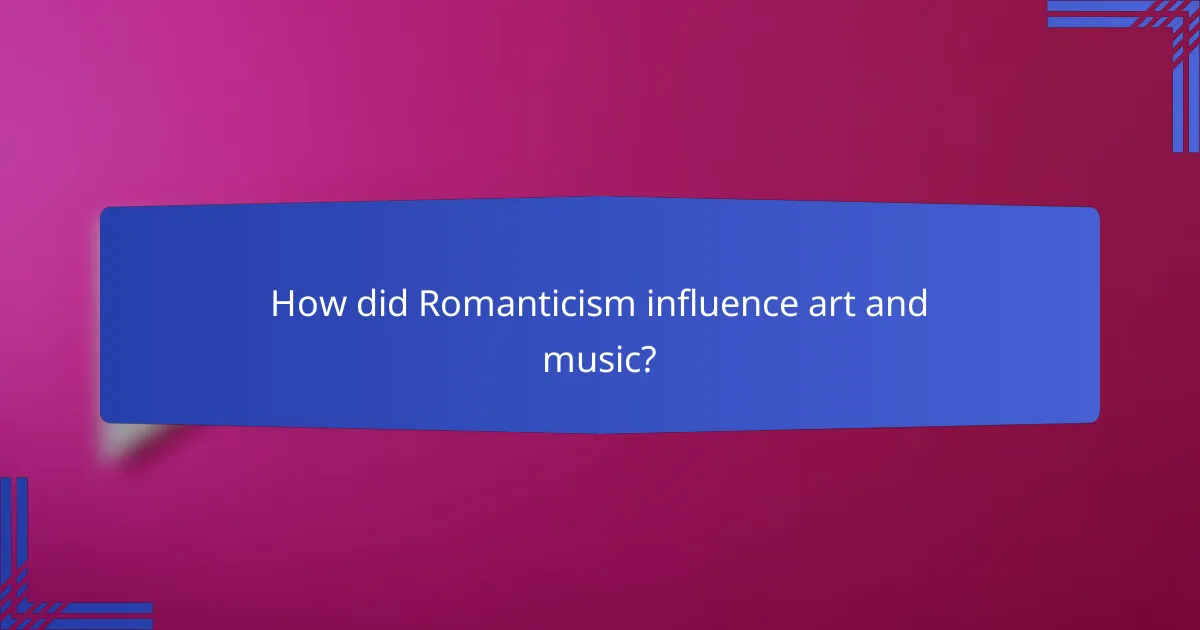
How did Romanticism influence art and music?
Romanticism significantly influenced art and music by emphasizing emotional depth and a profound connection to nature. This movement reacted against industrialization, celebrating individual expression and the beauty of the natural world.
Visual arts reflecting nature
Romantic visual arts often depicted landscapes, natural scenes, and the sublime, showcasing nature’s power and beauty. Artists like Caspar David Friedrich and J.M.W. Turner used dramatic lighting and color to evoke feelings of awe and introspection.
These artworks frequently featured themes of solitude and the human experience within the vastness of nature, inviting viewers to reflect on their own emotions and place in the world. The focus on natural elements served as a counterpoint to the mechanization of society during the industrial era.
Emotional expression in music
Romantic music is characterized by its emphasis on emotional expression and individualism, often exploring themes of love, nature, and the supernatural. Composers such as Franz Schubert and Johannes Brahms created works that conveyed deep feelings through rich harmonies and innovative structures.
This period saw the rise of program music, which aimed to tell a story or evoke imagery, further connecting listeners to the emotional landscape of the piece. The use of dynamics, tempo changes, and orchestration allowed musicians to express a wide range of emotions, making music a powerful medium for personal and collective experiences.
